 “What is the Cherokee connection to the outdoors today?” That’s the question Tuckasegee Reader co-publisher Giles Morris pondered earlier this year as he researched and wrote a feature for Blue Ridge Outdoors magazine. “I realized I wouldn’t be able to fit more than a handful of quotes in the assigned 3,000-word feature. I also had the feeling that I could have, or more to the point should have, interviewed many more people. More old people. More young people. More native speakers. More Oklahomans. More women,” says Morris in an April 25 release detailing his talk with Tom Belt, elder in residence in the Cherokee Studies Department at Western Carolina University.
“What is the Cherokee connection to the outdoors today?” That’s the question Tuckasegee Reader co-publisher Giles Morris pondered earlier this year as he researched and wrote a feature for Blue Ridge Outdoors magazine. “I realized I wouldn’t be able to fit more than a handful of quotes in the assigned 3,000-word feature. I also had the feeling that I could have, or more to the point should have, interviewed many more people. More old people. More young people. More native speakers. More Oklahomans. More women,” says Morris in an April 25 release detailing his talk with Tom Belt, elder in residence in the Cherokee Studies Department at Western Carolina University.
When I asked him about the Cherokee connection to the outdoors, [Tom Belt] started out by breaking down the constructs in the question. What is the outdoors, anyway? Is it nature? Outside? The Wilderness? “There is no Cherokee word for wilderness. We have no concept of that,’ Belt said. ‘What white people call wilderness is our home. We are a part of it and it is a part of us.”
Belt said that if you want to understand the Cherokee connection to the outdoors, or any other part of Cherokee history, you have to look back to the story of the Cherokee removal of the 1830s.
That’s where the rupture took place and where you can find the cultural scar that might offer some evidence about what you’re looking for in the question.
Belt talked about the first time he came from Tennessee over Newfound Gap and saw his ancestral home for the first time.
“I remember that in that time there was something indelible. It’s like being in a crowd and catching a glimpse of someone you think you know. You see them for a second and then you can’t find them anymore. I think it was true for everyone who was in that group.”
For the full story, click here.


